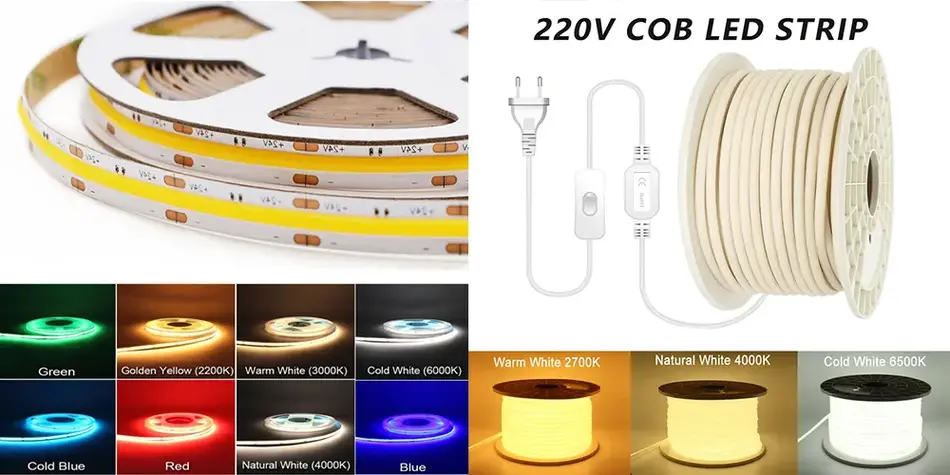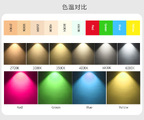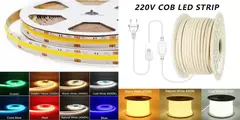24V vs 220V COB LED Strip Lights Comparison
Introduction
In the fast-evolving world of LED lighting, COB (Chip on Board) LED strip lights have become increasingly popular due to their uniform illumination, high efficiency, and sleek design. Among the many options available, two of the most widely discussed variants are 24V COB LED strip lights and 220V COB LED strip lights. While both serve similar purposes in terms of providing flexible linear lighting, their voltage, technical structure, and application suitability differ significantly.
For distributors, contractors, and end-users, understanding these differences is essential for selecting the right product for a specific project. This article explores the technical distinctions, advantages, disadvantages, and ideal use cases of 24V and 220V COB LED strip lights.

1. Understanding COB LED Technology
Before diving into voltage differences, it’s important to understand what COB technology means in LED strip lighting.
-
COB (Chip on Board) refers to mounting multiple LED chips directly onto a PCB (printed circuit board) substrate, forming a continuous lighting surface.
-
Compared to SMD (Surface-Mounted Device) strips, COB strips offer:
-
Smoother, dot-free illumination.
-
Higher light density per unit length.
-
Better heat dissipation.
-
This makes COB strips ideal for projects requiring seamless linear lighting without visible hotspots, such as decorative lines, under-cabinet lighting, or architectural accents.
2. Voltage Basics: 24V vs 220V
The most fundamental difference between 24V and 220V LED strip lights is their operating voltage.
-
24V LED Strips: Operate on low voltage DC power (24 volts direct current).
-
220V LED Strips: Operate on high voltage AC power (220 volts alternating current, commonly used in Europe and Asia; in North America, it’s closer to 110–120V).
This difference impacts circuit design, safety, installation, and performance in various applications.
3. Technical Differences
3.1 Power Supply Requirements
-
24V COB LED Strips: Require an external DC power supply (LED driver) to convert AC mains (110–220V) into 24V DC.
-
220V COB LED Strips: Can connect directly to household or commercial mains power (AC 220V) with just a small rectifier and driver integrated into the strip.
Key Point: 24V strips involve an extra power supply but provide safer low-voltage operation, while 220V strips eliminate bulky drivers but deal directly with high voltage.
3.2 Length of Continuous Runs
-
24V COB Strips: Typically limited to 5–10 meters per run without significant voltage drop. Beyond this length, brightness decreases unless parallel connections or amplifiers are used.
-
220V COB Strips: Can achieve long continuous runs of 50–100 meters because AC high voltage minimizes voltage drop across distance.
Key Point: For large installations requiring uninterrupted long strips, 220V is more practical. For shorter or modular installations, 24V is better.
3.3 Flexibility and Cutting Units
-
24V Strips: Can be cut into smaller segments, usually every 25–50mm, giving designers greater flexibility for custom lengths.
-
220V Strips: Cutting units are much larger, typically 0.5–1 meter, due to the high-voltage circuit design.
Key Point: 24V strips are superior for projects requiring precise customization.
3.4 Safety Considerations
-
24V Strips: Considered safe-to-touch, as 24V DC is low voltage and poses minimal risk of electric shock. Suitable for residential or DIY installations.
-
220V Strips: Carry risk of electric shock if improperly installed, requiring professional handling, proper insulation, and waterproofing in exposed areas.
Key Point: Safety regulations often favor low-voltage (24V) lighting in homes, furniture, and public installations.
3.5 Heat Generation & Efficiency
-
24V COB Strips: Generate less heat per unit length due to lower voltage operation, though heat still depends on wattage and density.
-
220V COB Strips: Generate more heat, especially over long runs, because AC-DC conversion and higher current in certain circuits produce extra thermal load.
Key Point: For enclosed or heat-sensitive spaces, 24V strips are usually the safer option.
3.6 Dimming and Control Options
-
24V COB Strips: Highly compatible with PWM dimmers, DMX systems, smart home controllers, and RGB/RGBW setups. Easy integration into modern lighting systems.
-
220V COB Strips: Limited dimming capabilities; usually require triac dimmers and are less compatible with advanced smart control systems.
Key Point: For smart lighting projects, 24V strips are much more versatile.
4. Application Scenarios
4.1 Residential Use
-
24V COB LED Strips:
-
Ideal for kitchens, under-cabinet lighting, wardrobes, and cove lighting.
-
Safe for family environments and DIY installation.
-
Compatible with smart home automation.
-
-
220V COB LED Strips:
-
More suitable for exterior facades, balconies, and long perimeter runs.
-
Should be installed by professionals due to high voltage risks.
-
4.2 Commercial and Industrial Use
-
24V Strips: Best for retail shelves, display cases, restaurants, and office interiors where fine control and aesthetic quality are important.
-
220V Strips: More practical for warehouses, signage, large shopping malls, or outdoor architectural lighting where long continuous runs are needed.
4.3 Outdoor and Architectural Use
-
24V COB Strips: Work well in landscaping, garden accents, and pool areas if waterproof-rated. Provide safety in areas accessible to people.
-
220V COB Strips: Common for building outlines, billboards, bridges, and street decorations, where long-distance runs minimize wiring complexity.
4.4 Professional vs DIY Installations
-
24V Strips: Easy for DIYers to install safely with plug-and-play power supplies.
-
220V Strips: Require professional electricians to ensure compliance with electrical codes and avoid safety hazards.
5. Advantages and Disadvantages
24V COB LED Strip Lights
Pros:
-
Safer low-voltage operation.
-
Short cutting units for precise installation.
-
Better compatibility with smart controls and dimming.
-
Less heat generation.
-
Suitable for residential and commercial interiors.
Cons:
-
Limited to shorter runs (5–10m).
-
Requires an external power supply, increasing cost and space usage.
220V COB LED Strip Lights
Pros:
-
Direct connection to mains power.
-
Long continuous runs (50–100m).
-
Fewer power supplies needed, reducing wiring complexity.
-
Suitable for large-scale outdoor projects.
Cons:
-
Safety risks due to high voltage.
-
Larger cutting units, less flexible for precise customization.
-
Limited dimming and smart control options.
-
More heat buildup.
6. Choosing the Right Option
When deciding between 24V and 220V COB LED strip lights, consider these factors:
-
Project Size:
-
Small to medium projects → 24V.
-
Large-scale outdoor or architectural runs → 220V.
-
-
Safety Requirements:
-
Residential, public, or accessible areas → 24V.
-
High-mounted, outdoor, or restricted-access areas → 220V.
-
-
Control and Flexibility:
-
Need for dimming, smart control, or RGB effects → 24V.
-
Basic illumination with long distances → 220V.
-
-
Installation Expertise:
-
DIY-friendly → 24V.
-
Professional electrician setup → 220V.
-
7. Future Trends
The demand for low-voltage smart lighting systems is growing, particularly in homes, hotels, and retail spaces. This trend favors 24V COB LED strips. Meanwhile, 220V COB strips will continue to dominate large-scale architectural and outdoor projects, especially where long continuous illumination is required.
Manufacturers are also working on improving dimming compatibility for 220V strips and developing hybrid driver solutions to balance long runs with safety and control.
summarize
Both 24V COB LED strip lights and 220V COB LED strip lights have unique strengths and limitations.
-
24V COB strips excel in safety, customization, and smart control, making them perfect for residential, commercial interiors, and projects requiring detailed lighting design.
-
220V COB strips shine in large-scale, long-distance, and outdoor applications, where minimizing power supply units and covering long spans are priorities.
For lighting designers, contractors, and businesses, the choice ultimately depends on application context, safety requirements, and control preferences. By understanding these differences, you can confidently select the most suitable COB LED strip light for your project and deliver efficient, professional, and lasting results.





